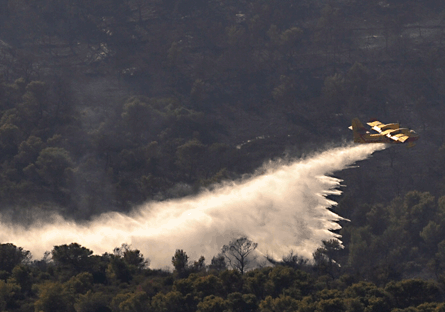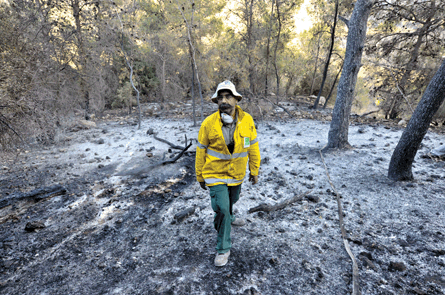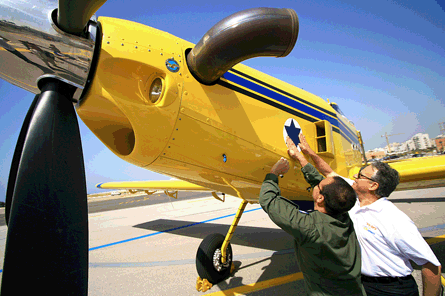It took a large-scale catastrophe to compel the Israeli government to allocate resources to forming a real aerial firefighting force. Having launched operations in May, this force will, it is hoped, be ready for fast reaction over the summer. All of the aircraft acquired for the squadron have already arrived in Israel.
In January, the Israeli government selected Elbit systems, one of Israel's major defence companies, as the prime contractor that will supply aerial firefighting services in Israel.
The decision to form such a squadron was made in the wake of a huge, deadly forest fire that swept the Carmel ridge, near the northern city of Haifa, in December 2010, claiming the lives of 45 people - most of them prison wardens and police officers, most of them in a bus but others in official cars.
 |
|---|
© Rex FeaturesForest fires in the Carmel ridge area of northern Israel claimed 45 lives in December 2010 |
The fire in the mountainous area could not be fought only from the ground, and the Ayres Turbo Thrush agricultural spraying aircraft that dispensed water and fire retardant on the fire were not sufficient. The enormous number of sorties they made had little effect on the fire that engulfed the whole ridge.
This forced the Israeli government to make an urgent request for international help. Within 48h, the international firefighting fleet flying over the area included some 30 aircraft and helicopters. Among those aircraft were Russian Ilyushin Il-76 and Beriev Be-200 firefighting aircraft, Bombardier 215/415s from Greece and Turkey, and the Boeing 747-200 Super Tanker.
The fire last December led to accelerated discussions aimed at forming a force of firefighting aircraft.
The defence ministry, which was asked to undertake the tender, selected a joint offer by Elbit Systems and Chimnir, a Herzliya-based operator of agricultural spraying aircraft. The two companies were selected to build the squadron that will be part of the Israeli air force and will operate from the Megido airfield in northern Israel.
The squadron is being formed under a private financing initiative. Elbit Systems is to supply trainer flight hours to the Israeli air force's flight academy.
Yoram Shmuely, co-general manager of Elbit Systems' aerospace division, said that the Israeli air force will be responsible for the squadron while Elbit will operate it with pilots from Chimnir.
The companies have purchased seven Air Tractor AT-802F aircraft, which are to be on scramble alert in the small airfield or in other airfields, according to circumstances. All of the aircraft have already landed in Israel. Two are equipped with Wipaire amphibious floats and, according to Chimnir chief executive David Golan, they will be capable of scooping water from the Mediterranean if the waves are below a height of 60cm (2ft). "In summer, when the fire hazard is the biggest, the waves are higher, and that will limit this capability," he acknowledges.
FUTURE OPTIONS
Golan confirms that, after at least one summer, the government may decide to buy a number of Bombardier 415 firefighting aircraft. Shmuely also says that the 415 is a future option and that its acquisition is dependent mainly on budgets.
The consequences of the fire last December were traumatic. When the huge blaze started on the Carmel mountain ridge in northern Israel, the firefighters seemed to be totally unprepared for it.
 |
|---|
© Rex FeaturesA firefighter stands on the burnt ground near Isfiya after the Carmel ridge bushfire |
For years, smaller fires in open areas had been fought from the ground, by agricultural spraying aircraft and - where the fires where of a larger scale - by Sikorsky CH-53 helicopters of the Israeli air force. These carried large buckets attached to cables and released the water scooped from the Mediterranean or the Sea of Galilee.
After a number of missions, the air force - which does not have any immediate replacement for its CH-53s - decided not to use the aircraft any more, as the heat and smoke had affected their health.
Over the past 20 years there had been some initiatives to form an aerial firefighting force, but these did not bring any result, even on a small scale. The 215 was demonstrated off the Tel Aviv coast almost 15 years ago, but that was not followed by any concrete actions to buy or lease this type or similar types.
When the huge fire started, the first forces in the area were fire engines from northern fire stations. It took an hour to understand that this fire was different.
When the small agricultural spraying Turbo Thrush aircraft were called in, it was discovered that the fire retardants available would last for only a few missions. Foreign countries were asked to make emergency shipments, and an El Al 747-400 cargo aircraft rushed a first shipment from Europe within 12h.
But this also was not enough, and the blaze ran out of control. Israel had no choice but to ask for further international help. A country with one of the most modern air forces in the world had to wait for firefighting aircraft sent by other governments.
It was only after two days of fighting the blazes that the Russian Il-76 and Be-200 finally joined the effort, lining up with helicopters from Cyprus as well as the 215/415s from Greece and Turkey.
SUPER TANKER
That was not enough, and on 4 December the Israeli government decided to contract Evergreen to operate the 747-200 Super Tanker. This large firefighting bomber made a few sorties over the fire. However, it was too late to stop the fast spreading fire.
It was then that Benjamin Netanyahu, the Israeli prime minister, demanded fast action to build a local aerial firefighting unit.
 |
|---|
© IDFSeven Air Tractor AT-802F aircraft were bought for the squadron |
The potential to sell firefighting aircraft to Israel brought a Be-200 to the country for a demonstration, and other companies made preparations for similar events.
The selection of Elbit systems as a prime contractor and Chimnir as a subcontractor to form the first Israeli firefighting squadron made sense. The two companies have the financial resources and the know-how to get the squadron fully operational very soon.
The seven AT-802Fs have been undergoing preparations for their mission, and Israeli pilots have been making efforts to become familiar with their systems. The summer will, without any doubt, bring opportunities to test the efficiency of the aircraft.
Experts say that what is most important is to "hit the flames" as soon as possible, and that is why the squadron is being organised like an Israeli air force fighter squadron, trained and ready to scramble two Boeing F-15s towards the border when the first indication of an approaching threat is seen on the radar screens.
Source: Flight International



















